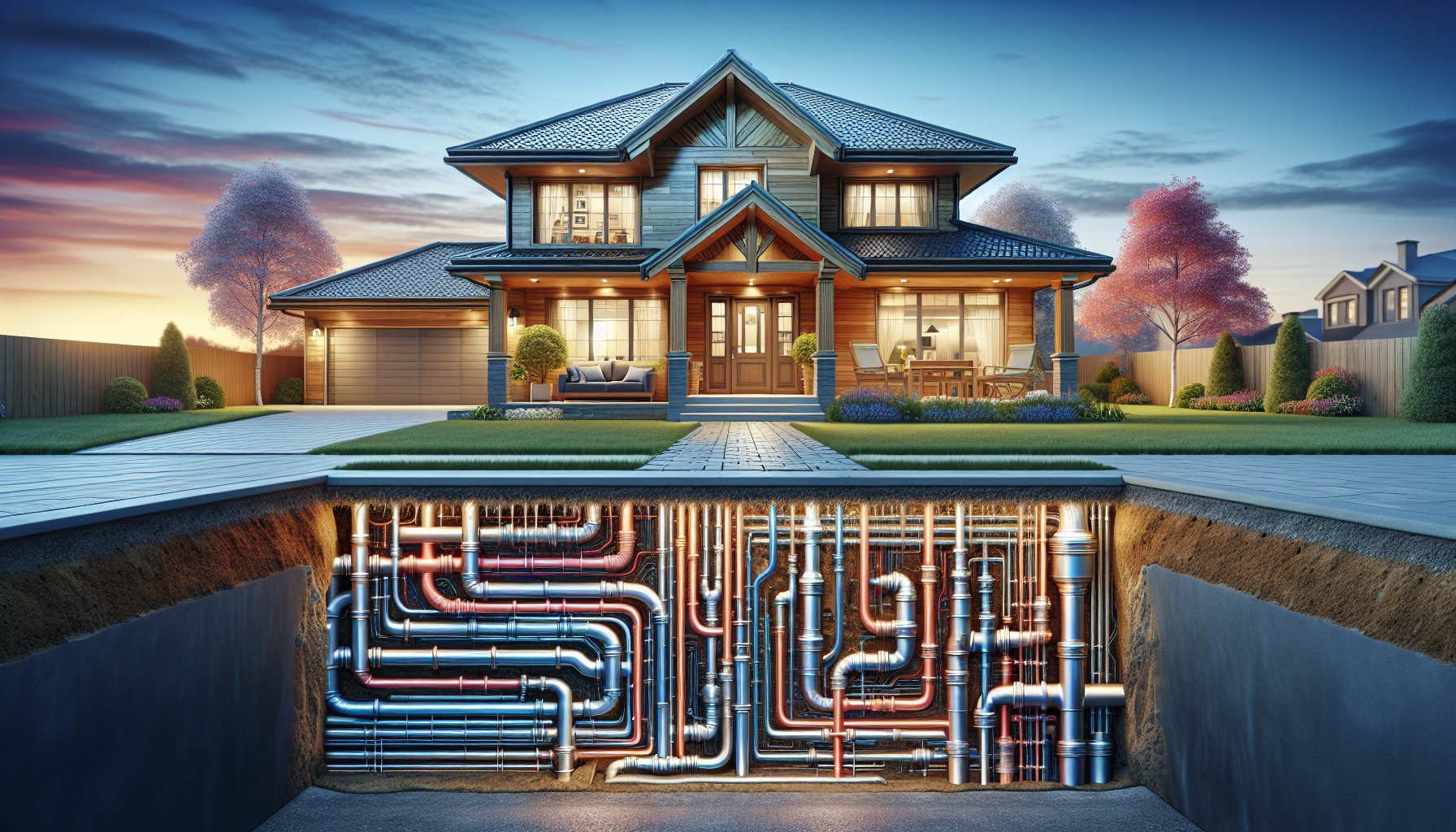
Does Home Insurance Cover Plumbing: Navigating Underground Pipe Coverage
When homeowners confront unexpected plumbing issues, especially concerning underground pipes, one of the first questions that arise is: does home insurance cover plumbing? This query is not only common but critical, given the potentially high costs involved in repairing or replacing underground plumbing. Understanding what is covered and what is not can save homeowners from significant financial strain. Particularly, it’s important for policyholders to be aware of home insurance claim adjuster secret tactics, as these can significantly impact the settlement of claims.
This article delves into the coverage for underground pipes, distinguishing between standard home insurance coverage and specific situations where a claim might be viable. It also highlights the importance of being informed about one’s policy through united home insurance, home state county mutual insurance, and the pertinent questions to ask home insurance agent to ensure comprehensive coverage. Furthermore, it emphasizes the relevance of preventative measures homeowners can take to mitigate potential damages. Through this roadmap, readers will gain a clear understanding of how home insurance relates to plumbing and how to navigate the complexities of filing a claim.
Understanding Underground Pipes
Types of Underground Pipes
Underground pipes, also known as service lines, are crucial for transporting various utilities to residential areas. These include water lines, sewer lines, heating systems, electrical lines, natural gas, cable, and internet connections. These service lines ensure the efficient delivery of essential utilities based on the specific location and needs of the community.
Common Issues with Underground Pipes
Homeowners often face challenges with underground pipes, as issues are not apparent until a malfunction occurs. Common problems include leaks, bursts, and blockages, which can lead to significant damage and costly repairs. For instance, a sudden spike in the water bill might indicate a leak in the water line, necessitating thorough investigation and potentially extensive excavation to repair. Additionally, underground pipes are susceptible to damage from aging, wear and tear, and lack of maintenance, which are typically not covered under standard home insurance policies.
Regular maintenance and awareness of the conditions of these pipes can prevent severe issues. Homeowners are advised to conduct regular inspections and consider additional coverage options for underground service lines to mitigate risks and ensure the longevity of their plumbing infrastructure.
Standard Home Insurance Coverage
Basic Inclusions
- Standard home insurance policies typically cover damages to underground pipes caused by sudden and accidental events, including those related to sewer lines.
- Coverage often extends to the cost of repairs for pipes and drains, as well as expenses incurred in locating the source of the damage, which might include the reconstruction of walls, paths, or fences removed or damaged during the search.
- If an underground pipe is damaged by a covered peril, such as hail, windstorms, explosions, lightning, fire, damages caused by vehicles, vandalism, or falling objects, it would generally be protected under most standard homeowners’ insurance policies.
- Homeowners insurance may also cover water that backs up into your house as long as the blockage is within the plumbing system on your property.
Common Exclusions
- Damage caused by floods, other natural disasters, or man-made errors such as construction mishaps may require an additional rider for coverage as these are often not included in basic policies.
- Gradual damage, corrosion, wear and tear, or improper use of the plumbing system are usually not covered by standard home insurance policies.
- Issues related to poor upkeep, such as blockages caused by flushing inappropriate items down the toilet or disposing of cooking oil and food waste down the sink, are typically excluded from coverage.
- Damage attributed to faulty construction, poor design, or lack of maintenance, as well as damages resulting from pests, earthquakes, or tree roots, are commonly not covered.
- Sewer backups and sump pump failures are generally not automatically covered by a homeowners policy, although options for sewer backup coverage may be available as an add-on.
This overview of standard home insurance coverage for plumbing highlights the importance of understanding one’s policy, including what is typically covered and what is excluded. Homeowners should carefully review their insurance documents and discuss their coverage needs with their insurance agent to ensure they have adequate protection for their underground pipes.
Coverage for Underground Pipes
Scenarios where coverage is available
- Homeowner’s insurance policies may cover the cost of repairing issues with exterior wiring and plumbing, including damages caused by faulty electrical wiring, interior pipe damage due to poor insulation or age, and water damage from a leaky roof.
- Coverage for damages within the home’s foundation, such as break or hole in a pipe, is more likely compared to incidents occurring outside the home’s foundation “footprint”.
- Claims for condensation line overflow from air-conditioners, broken water hoses into the washer, and burst pipes due to freezing (with the heat on) are often approved.
- Most homeowner’s insurance policies should cover sudden and unexpected water damage due to a broken pipe or plumbing malfunction, though coverage for the actual broken pipes depends on the source of the water damage.
- Damage from a broken pipe with a gradual or slow leak is often disputed, yet both types of pipe breaks can compromise the structure of your home, condo, or business.
Optional add-ons and endorsements
| Coverage Aspect | Details |
|---|---|
| Underground Service Line Coverage | Standard home insurance policies exclude coverage for service lines underground leading to your home. Adding this coverage can bridge the gap, covering costs for excavation, repairs, and replacements, and even additional living expenses. |
| Service Line Endorsement | This endorsement provides coverage for underground piping and wiring that fails due to a leak, break, tear, rupture, or collapse. It includes coverage for excavation costs, loss of use, and outdoor property damage, with a typical limit of liability up to $10,000. |
| Service Line Coverage | Often covering up to $10,000, this endorsement can be added to many home insurance policies to cover the repair or replacement of a broken utility line, including water pipes, power lines, cables, and the main sewer line. It may cover damages from degradation, damage, and breakdown, including excavation and landscaping costs. |
| ISO Homeowners Endorsement | Launched to address damage to underground utility lines not covered in standard policies. It covers underground pipes, wires, and some buried equipment from causes like explosions and tree root growth, including additional living expenses and loss of rental income. |
By understanding the scenarios where coverage is available and considering optional add-ons and endorsements, homeowners can ensure they have comprehensive protection for their underground pipes and avoid unexpected financial burdens.
Preventative Measures for Homeowners
Regular Maintenance Tips
Homeowners can avoid many common plumbing issues through regular maintenance and awareness. For instance, understanding that the responsibility for the sewer line extends from the house to the public connection is crucial. Regular inspections, especially for homes older than ten years, can reveal the condition of underground sewer lines, potentially avoiding costly repairs starting at $2,000. Preventing tree root infiltration, a common cause of sewer line damage, involves recognizing signs like slow draining or unusually green patches of grass in the yard. Additionally, avoiding harsh chemicals in drains, watching what goes down drains, using garbage disposals correctly, and preventing frozen pipes through insulation and proper water flow can prolong the plumbing system’s life and prevent leaks and clogs.
Evaluating Additional Coverage Needs
To navigate insurance coverage effectively, homeowners should conduct routine inspections and maintenance of underground pipes to identify and address potential issues early, reducing the risk of unexpected failures. Maintaining records of maintenance, repairs, and any communication with insurers regarding underground pipe-related matters can be crucial when filing claims. This proactive approach not only ensures the proper functioning of vital systems but also strengthens the likelihood of insurance coverage in case of unforeseen issues. Regular inspections, timely repairs, and proactive measures to prevent potential problems are essential.
By implementing these preventative measures, homeowners can mitigate risks and ensure they have adequate coverage in place to safeguard their properties from unforeseen pipe-related challenges.
Conclusion
Navigating the complexities of home insurance coverage for plumbing, especially concerning underground pipes, requires a thorough understanding of one’s policy, awareness of add-on options, and a strong commitment to preventative maintenance. By identifying the scenarios where coverage is most likely to apply and leveraging additional endorsements, homeowners can significantly enhance their protection against potential financial burdens due to plumbing malfunctions. It’s imperative to conduct regular inspections and maintenance, not only to preserve the integrity of the plumbing system but also to ensure that insurance claims, when necessary, are supported by a well-maintained property infrastructure.
In conclusion, while standard home insurance policies may offer a basic level of coverage for underground pipes, the real peace of mind comes from understanding the specifics of one’s policy and taking proactive steps towards maintenance and additional coverage. Homeowners are advised to engage in regular dialogue with their insurance agents to clarify their coverage scope and explore options for service line endorsements that can offer comprehensive protection. This approach ensures that when faced with the unexpected, homeowners are not left navigating the aftermath alone but are well-prepared and supported by their insurance coverage.


